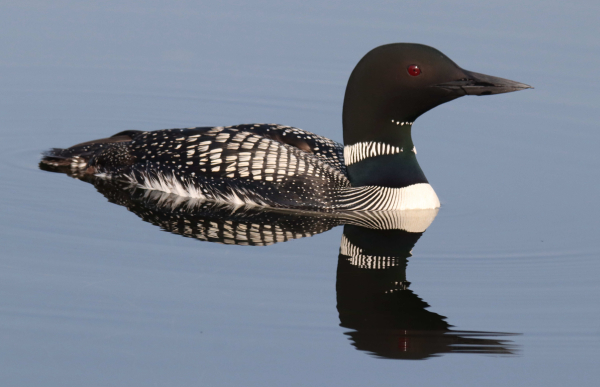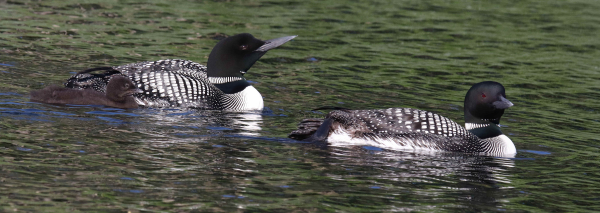
The oldest known Common Loon has been studied for almost 40 years at Seney National Wildlife Refuge.

Banding of hatchling and adult Common Loons has provided a variety of interesting information about loon behavior, reproductive success, and longevity (photos by Paul Konrad).
|
The simple act of banding Common Loons by biologists has produced some remarkable information about this popular species of waterbirds during the past 4 decades. A simple numbered aluminum leg band with a tell-tale colored leg band on 2 special Common Loons at Seney National Wildlife Refuge in the Upper Peninsula of Michigan has provided some interesting information about loon longevity, pairing behavior, and reproductive success. To begin with, the male is known to be 38 years old this summer, and the female is even older!
At Seney Refuge, for 25 years the same mated pair of Common Loons reconnected each spring, nested, and raised young together – a total of 32 young loons – a record for any pair studied to date. Common Loons don’t typically mate for life, and the individuals of this pair were mated to other loons before they began their 25 year nesting run, but even this pair eventually separated and paired with other loons within refuge waters.
Refuge biologists banded the male in 1987 when he was a young hatchling. In 1990, biologists banded the female when she was an adult and already successful in raising young, which made her at least 4 years old, thereby indicating that she hatched in 1986, or before – making her the oldest known Common Loon overall.
The “oldest loons” are known to nest and raise young together for 25 years, from 1996 to 2021 as a mated pair. But during the spring of 2022, although the pair returned to their nesting territory, sometime thereafter they separated and the female paired with a different male, moved to another nesting territory, and raised a single hatchling. The duo of the oldest known Common Loons have paired with other loons since then, and both were back at Seney National Wildlife Refuge earlier this year.
Every species of birds has its own story to tell, and as biologists and researchers continue to band and study birds, we learn more and more about their longevity, habitat use, food selection, migrations, and wintering areas, all so very interesting and very important for the conservation of lands and wildlife across America and beyond our borders. For more information about this study of Common Loons, and about other ongoing work by the US Fish & Wildlife Service and US Geological Survey, refer to The oldest known common loons | U.S. Fish & Wildlife Service (fws.gov)